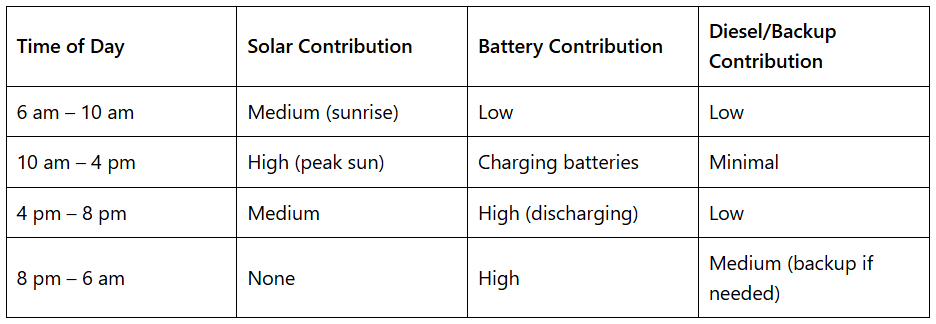
Reliable Power for Remote Ranches
Energy security has long been one of the biggest challenges for ranches situated far from urban centers. Traditional solutions—diesel generators or costly grid extensions—are proving increasingly unsustainable in terms of cost, logistics, and environmental impact.
In recent years, hybrid photovoltaic (PV) systems have emerged as a practical and profitable alternative. By combining painéis solares, battery storage, and a backup power source such as a diesel generator or limited grid access, these systems offer ranchers a balance of reliability, cost savings, and long-term sustainability.
How Hybrid Solar Systems Work
A hybrid PV system integrates three key components:
- Painéis solares: Generate renewable electricity during daylight hours.
- Battery storage: Stores surplus power for use at night or on cloudy days.
- Backup source: Provides supplemental energy when solar and batteries cannot meet demand.
This layered approach ensures that ranch operations—such as water pumping, cold storage, and housing—are never interrupted, while minimizing reliance on expensive or unstable diesel fuel.
Chart 1: Energy Flow in a Hybrid PV System (24-Hour Cycle)

This model shows that most daily electricity needs can be met through solar plus storage, with diesel use limited to periods of unusually high demand or low sunlight.
The Hidden Costs of Diesel Reliance
For many ranchers, diesel has historically been the default energy source. However, the financial and logistical drawbacks are increasingly difficult to ignore:
- Fuel transport: Delivering fuel to remote sites can double the per-liter cost.
- Maintenance: Generators require frequent servicing, leading to higher labor and parts expenses.
- Supply interruptions: Bad weather or transport delays can leave ranches without power for days.
Meanwhile, extending the utility grid remains cost-prohibitive. The U.S. Department of Energy estimates that new transmission lines can cost $30,000–$80,000 per mile, making grid access impractical for properties located tens of miles from the nearest connection point.
Cost-Benefit Analysis: Hybrid PV vs. Diesel vs. Grid Extension
When analyzed over a 10-year period, hybrid PV systems demonstrate clear financial advantages.
Chart 2: Estimated 10-Year Energy Costs for a Medium-Sized Remote Ranch (100 kW Demand)

Findings:
- Diesel-only systems result in the highest total cost due to recurring fuel expenses.
- Grid extension demands enormous upfront capital, often exceeding land value.
- Hybrid PV delivers the lowest long-term cost, with payback typically achieved in 4–6 years.
More Than Just Cost Savings
While financial benefits are compelling, hybrid PV systems also deliver strategic advantages for ranch owners:
- Energy independence – Reduced exposure to volatile fuel markets and supply risks.
- Resilience – Continuous operation during storms, delivery delays, or grid outages.
- Escalabilidade – Systems can be expanded as ranch operations grow.
- Sustentabilidade – Lower carbon footprint improves environmental performance and strengthens reputation, especially for ranches involved in eco-certified agriculture.
Case Study: A Remote Cattle Ranch in Texas
A cattle ranch operating across 2,500 acres recently transitioned from diesel-only to a hybrid solar solution.
Before:
- Annual fuel and maintenance costs: $52,000
- Frequent generator failures interrupted irrigation schedules and meat refrigeration.
After Hybrid PV Installation (100 kW panels, 300 kWh lithium storage, 40 kW backup diesel):
- Upfront cost: $185,000
- Annual operating cost: $5,000
- Payback achieved in 5 years.
- Over 10 years, savings exceeded $270,000, while diesel usage dropped by 70%.
Chart 3: Annual Energy Mix at the Texas Ranch (Post-Hybrid Installation)

This balance highlights how solar and batteries supply the majority of ranch operations, with diesel serving only as a supplementary safeguard.
Key Factors to Evaluate Before Adoption
For ranchers considering hybrid PV investment, several elements should guide decision-making:
- System sizing: Accurate load assessment is essential to ensure efficiency.
- Financing: Incentives, tax credits, and rural development grants can reduce upfront barriers.
- Technology trajectory: Battery prices are projected to decline another 40% by 2030, improving returns.
- Maintenance: While hybrid systems require less attention than diesel generators, professional monitoring ensures consistent performance.
Market Outlook: Hybrid Solar in Agriculture
The agricultural sector is increasingly seen as a growth driver for hybrid solar adoption. According to BloombergNEF, global off-grid and hybrid solar capacity is projected to grow by more than 12% annually through 2030, driven by lower battery costs and advances in digital monitoring.
In markets such as Australia, Latin America, and the U.S. ranching belt, hybrid PV is rapidly replacing diesel as the preferred energy model. Policy frameworks, including renewable energy subsidies and carbon reduction mandates, are further accelerating uptake.
Conclusion: The Smart Energy Transition for Ranches
For ranchers, the choice of energy system is no longer just about keeping the lights on. It is a strategic investment that impacts profitability, resilience, and long-term competitiveness.
Diesel systems lock ranches into rising fuel costs and operational risks. Grid extensions remain financially unrealistic for most properties. In contrast, hybrid PV systems provide a balanced solution—affordable, reliable, and future-proof.
By adopting hybrid solar today, remote ranches can secure lower energy costs, improved sustainability credentials, and greater operational stability. For many property owners, the transition is not only possible but increasingly inevitable.
Apelo à ação
Sunpal Solar specializes in designing and delivering hybrid PV systems tailored for remote agricultural operations. If you are a ranch owner or investor exploring long-term energy solutions, our team can provide customized cost-benefit assessments and system designs.
Contactar a Sunpal Solar to learn how a hybrid PV system can cut your ranch’s energy costs and secure its future.
